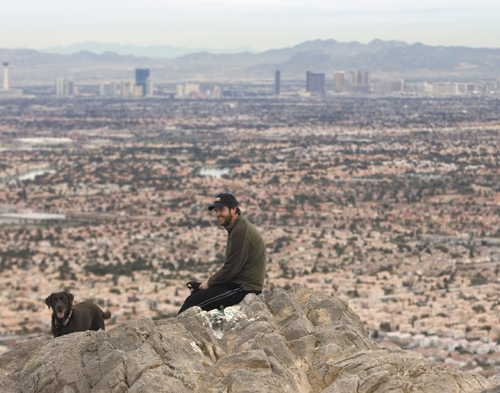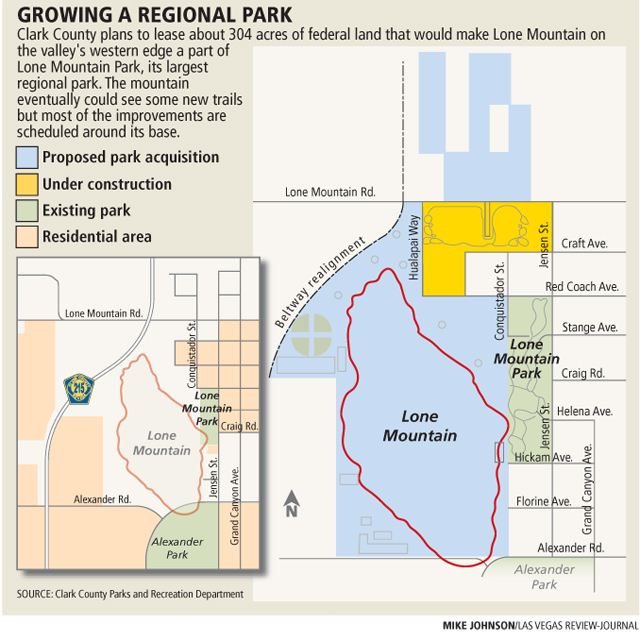Park will become biggest in region with addition of 304 acres




From Lone Mountain’s jutting summit at nightfall, the lighted playground, hard courts and picnic areas below look like glowing postage stamps.
The Strip is a tiny, neon silhouette in the distance, enveloped in myriad lights speckling the valley. To the west, a procession of taillights stream along the Las Vegas Beltway.
Roughly 600 feet high, the rocky, furrowed mesa and popular hiking spot at the valley’s northwest corner is about to become the centerpiece of a regional park. At least on paper.
Clark County officials are preparing to lease about 304 acres at no cost from the federal Bureau of Land Management that would encompass Lone Mountain and make it the county’s biggest park. The new area eventually would be used for the park’s third phase of development.
The mountain itself will remain mostly unchanged. Park officials might someday improve the path that runs up a craggy slope and build a trail at the base.
Third-phase plans mainly call for adding a host of amenities near the mountain, including a swimming pool, library, tennis courts, basketball courts, playgrounds, picnic areas and restrooms.
But with park funds shrinking, those plans appear more distant than the Strip’s cityscape on the horizon.
"You sort of do a general wish list of everything you’d want to put in there if you had all the money you needed to build," said Krynn Williams, the county’s property acquisition administrator.
For now, the county is tackling a smaller project in the park’s second phase.
About $8 million in new amenities will be built on 10.5 acres at the park’s north side. They will include four basketball courts, six tennis courts, eight horse-shoe pits, seven bachi ball courts, a picnic area, a playground and two restroom facilities.
The work will go out to bid at the end of January and is scheduled to be finished within 18 months.
The county is using capital funds that were earmarked in 2005 and limited to improving parks, and no money is being taken from essential services in the budget crunch, said Jane Pike, county parks and recreation director.
Lone Mountain’s expansion was planned for years, but the county had to wait for the Beltway to be realigned before any work could be done, Williams said. "We needed to know what the park’s boundaries were going to be."
Lone Mountain’s first phase was finished several years ago.
It features two tennis courts, a basketu2260ball court, two picnic areas, a roller hockey rink and a playground, known as the Lone Mountain Children’s Discovery Park because of an educational component.
On one afternoon last week, Rachel Galegos, who lives near the park, watched her 2-year-old boy, Jack, play on the equipment. She was happy that more tennis courts would be built.
She said the two existing courts are always taken on weekends when the weather is pleasant. If she and her friends want to play doubles, they must look elsewhere, sometimes as far away as Summerlin.
"This is a popular park," Galegos said.
A bigger park can draw troubleu2260makers, she said. But so far, she has noticed only an occasional rowdy group drinking in a covered picnic area.
Not far from the tennis courts, Don MacIntyre, 68, was walking his dog.
MacIntyre said he had heard about the park’s second phase and thinks the money should be used to avoid layoffs at the county.
He was referring to the more than 200 employees who have been laid off, and the prospect of more cuts in staffing this year.
"It would be nice to expand the park," MacIntyre said. "Although with today’s budget cuts, I would think there are better ways to spend the money."
If the funds are restricted to park improvements, perhaps the money should go to a different park, he said.
He motioned to the park that was almost empty, in large part because of the chilly weather, and questioned whether a bigger one was really needed in this less populated part of the valley.
He also wondered how the county would maintain larger parks with its dwindling resources.
The park’s current amenities cost about $1,645 a year in maintenance and about $120,000 in utilities.
When the next phase is finished, it will cost $750 a year to maintain the 10.5 acres and $55,000 yearly for utilities, according to a county official.
Another 10 acres of open space might be added, doubling the total costs to about $112,000, the official said.
Regional parks serve a larger radius than smaller neighborhood and community parks, Pike said, adding that they aren’t limited to the immediate area.
Lone Mountain is one of seven regional parks, all of them at least 150 acres in size. The others are Sunset, Desert Breeze, Silver Bowl, Hollywood, Mountain’s Edge and the Southwest Regional Sports Park.
Sunset is the biggest, at 340 acres. But Lone Mountain will surpass it when the new BLM lease expands the area to 400 acres.
Improvements to the parks are paid for with county capital funds and federal money from BLM land sales, Pike said.
The county coordinates with the cities in planning large parks to avoid duplication, Pike said.
For instance, Lone Mountain is across the street from Majestic, a city of Las Vegas park with a dozen softball fields.
Majestic complements Lone Mountain, which has no ball fields and none planned, Pike said.
By expanding Lone Mountain, the county is inching toward its goal of providing at least 2.5 acres of parks per 1,000 residents in unincorporated areas, Pike said. A year ago, the ratio was 2 acres for every 1,000 residents, though the county has since developed or added more parkland.
Some municipalities in other states require 5 or 6 acres of parks per 1,000 residents, Pike said, "so 2.5 is what I would call a minimal goal, but probably more attainable."
Regional parks are long-term projects that typically are done in multiple phases over years, even decades, Pike said.
Sunset Park recently got $11 million in upgrades and will receive $11 million more in the spring, the latest in the park’s 43-year history.
Improving parks in stages is the most equitable approach, because it lets the county handle dozens of parks at a time, Pike said. If the county focused on one park until all the work was done, it would neglect many other parks.
But spreading the funds around means that parks like Lone Mountain might go years with little or no work, Pike said.
With the county’s budget crisis worsening and BLM funds drying up, the current Lone Mountain project could be the last significant upgrade to a regional park for a long time, Pike said.
"I think we’re hitting the end," Pike said. "I don’t want to be pessimistic, but it could be (years)."
Contact reporter Scott Wyland at swyland@reviewjournal.com or 702-455-4519.












